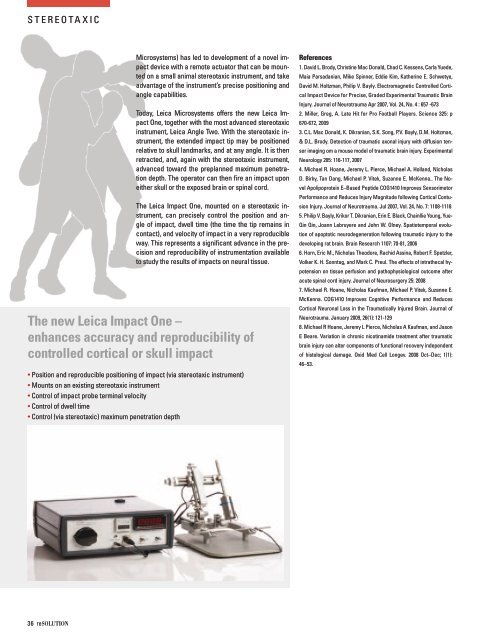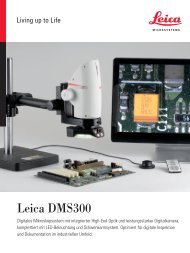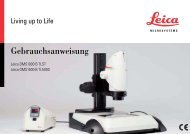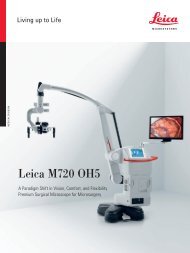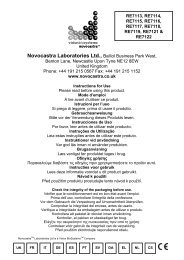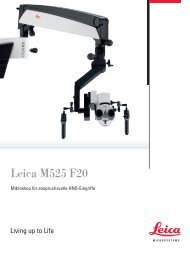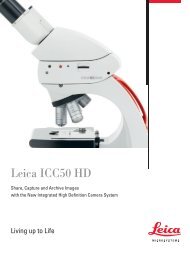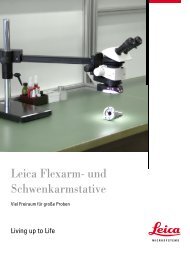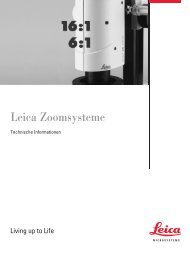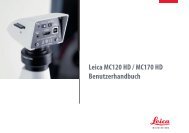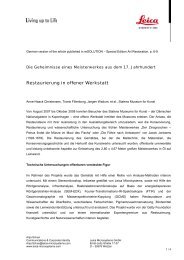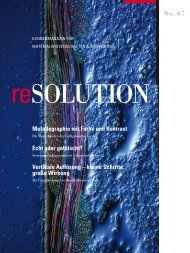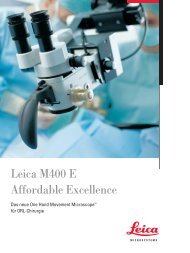reSOLUTION_Research_09_Neuroscience - Leica Microsystems
reSOLUTION_Research_09_Neuroscience - Leica Microsystems
reSOLUTION_Research_09_Neuroscience - Leica Microsystems
You also want an ePaper? Increase the reach of your titles
YUMPU automatically turns print PDFs into web optimized ePapers that Google loves.
stereotaXic<br />
36 resolutioN<br />
microsystems) has led to development of a novel impact<br />
device with a remote actuator that can be mounted<br />
on a small animal stereotaxic instrument, and take<br />
advantage of the instrument’s precise positioning and<br />
angle capabilities.<br />
today, leica microsystems offers the new leica impact<br />
one, together with the most advanced stereotaxic<br />
instrument, leica angle two. With the stereotaxic instrument,<br />
the extended impact tip may be positioned<br />
relative to skull landmarks, and at any angle. it is then<br />
retracted, and, again with the stereotaxic instrument,<br />
advanced toward the preplanned maximum penetration<br />
depth. the operator can then fire an impact upon<br />
either skull or the exposed brain or spinal cord.<br />
the leica impact one, mounted on a stereotaxic instrument,<br />
can precisely control the position and angle<br />
of impact, dwell time (the time the tip remains in<br />
contact), and velocity of impact in a very reproducible<br />
way. this represents a significant advance in the precision<br />
and reproducibility of instrumentation available<br />
to study the results of impacts on neural tissue.<br />
The new <strong>Leica</strong> Impact One –<br />
enhances accuracy and reproducibility of<br />
controlled cortical or skull impact<br />
• Position and reproducible positioning of impact (via stereotaxic instrument)<br />
• mounts on an existing stereotaxic instrument<br />
• control of impact probe terminal velocity<br />
• control of dwell time<br />
• control (via stereotaxic) maximum penetration depth<br />
References<br />
1. david l. brody, christine mac donald, chad c. Kessens, carla yuede,<br />
maia Parsadanian, mike spinner, eddie Kim, Katherine e. schwetye,<br />
david m. Holtzman, Philip V. bayly. electromagnetic controlled cortical<br />
impact device for Precise, graded experimental traumatic brain<br />
injury. Journal of neurotrauma apr 2007, Vol. 24, no. 4 : 657 -673<br />
2. miller, greg, a. late Hit for Pro football Players. science 325: p<br />
670-672, 20<strong>09</strong><br />
3. c.l. mac donald, K. dikranian, s.K. song, P.V. bayly, d.m. Holtzman,<br />
& d.l. brody. detection of traumatic axonal injury with diffusion tensor<br />
imaging om a mouse model of traumatic brain injury. experimental<br />
neurology 205: 116-117, 2007<br />
4. michael r. Hoane, Jeremy l. Pierce, michael a. Holland, nicholas<br />
d. birky, tan dang, michael P. Vitek, suzanne e. mcKenna.. the novel<br />
apolipoprotein e–based Peptide cog1410 improves sensorimotor<br />
Performance and reduces injury magnitude following cortical contusion<br />
injury. Journal of neurotrauma. Jul 2007, Vol. 24, no. 7: 1108-1118<br />
5. Philip V. bayly, Krikor t. dikranian, erin e. black, chainllie young, yue-<br />
Qin Qin, Joann labruyere and John W. olney. spatiotemporal evolution<br />
of apoptotic neurodegeneration following traumatic injury to the<br />
developing rat brain. brain research 1107: 70-81, 2006<br />
6. Horn, eric m., nicholas theodore, rachid assina, robert f. spetzler,<br />
Volker K. H. sonntag, and mark c. Preul. the effects of intrathecal hypotension<br />
on tissue perfusion and pathophysiological outcome after<br />
acute spinal cord injury. Journal of neurosurgery 25: 2008<br />
7. michael r. Hoane, nicholas Kaufman, michael P. Vitek, suzanne e.<br />
mcKenna. cog1410 improves cognitive Performance and reduces<br />
cortical neuronal loss in the traumatically injured brain. Journal of<br />
neurotrauma. January 20<strong>09</strong>, 26(1): 121-129<br />
8. michael r Hoane, Jeremy l Pierce, nicholas a Kaufman, and Jason<br />
e beare. Variation in chronic nicotinamide treatment after traumatic<br />
brain injury can alter components of functional recovery independent<br />
of histological damage. oxid med cell longev. 2008 oct–dec; 1(1):<br />
46–53.


